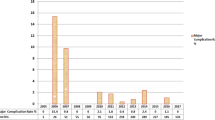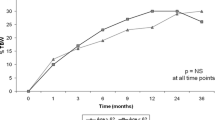Abstract
Background
Laparoscopic sleeve gastrectomy (LSG) is a recent bariatric procedure that has gained widespread popularity in morbidly obese adults. However, pediatric bariatric surgery is controversial, and the type(s) of bariatric surgery that are suitable for children and adolescents is under debate. No studies exit that compare LSG outcomes in adult and pediatric patients. We reviewed our experience to assess the safety, efficacy, and complications of LSG in adult and pediatric morbidly obese patients.
Methods
A retrospective review of all patients who underwent LSG by a single surgeon between March 2008 and February 2011 was performed. The 222 patients included 108 pediatric patients aged 21 years or younger and 114 adult patients older than 21 years. Baseline, operative, perioperative, and available follow-up data were abstracted.
Results
Pediatric patients had a mean age of 13.9 ± 4.3 years and a mean baseline body mass index (BMI) of 49.6 kg/m2, whereas adults had a mean age of 32.2 ± 9.4 years and a mean baseline BMI of 48.3 kg/m2. Our pediatric group achieved a mean percent of excess weight loss (%EWL) of 32.4, 52.1, 65.8, and 64.9 % at 3, 6, 12, and 24 months postoperative, respectively, compared with a mean %EWL of 30.9, 55.2, 68.5, and 69.7 %, respectively, in our adult group (p > 0.05). During the 24-month follow-up period, pediatric patients attended 71.7 % of follow-up visits, whereas adults attended 61.2 % of follow-up visits (p = 0.01). Postoperative complications occurred in six (5.6 %) and eight (7 %) pediatric and adult patients, respectively.
Conclusions
Laparoscopic sleeve gastrectomy in the pediatric age group is of similar safety and effectiveness compared with adults. Pediatric patients had fewer major complications and were more compliant with follow-up than adults. Nevertheless, long-term results are required to further clarify the safety and effectiveness of LSG in pediatric patients.
Similar content being viewed by others
References
Ogden CL et al (2012) Prevalence of obesity and trends in body mass index among U.S. children and adolescents, 1999–2010. JAMA 307(5):483–490
Reilly JJ, Kelly J (2011) Long-term impact of overweight and obesity in childhood and adolescence on morbidity and premature mortality in adulthood: systematic review. Int J Obes (London) 35(7):891–898
Arens R, Muzumdar H (2010) Childhood obesity and obstructive sleep apnea syndrome. J Appl Physiol 108(2):436–444
De Ferranti SD, Osganian SK (2007) Epidemiology of paediatric metabolic syndrome and type 2 diabetes mellitus. Diab Vasc Dis Res 4(4):285–296
Riley MR et al (2005) Underdiagnosis of pediatric obesity and underscreening for fatty liver disease and metabolic syndrome by pediatricians and pediatric subspecialists. J Pediatr 147(6):839–842
Pinhas-Hamiel O et al (1996) Increased incidence of non-insulin-dependent diabetes mellitus among adolescents. J Pediatr 128(5 Pt 1):608–615
Serdula MK et al (1993) Do obese children become obese adults? A review of the literature. Prev Med 22(2):167–177
Schwimmer JB, Burwinkle TM, Varni JW (2003) Health-related quality of life of severely obese children and adolescents. JAMA 289(14):1813–1819
Burke V et al (2004) Associations between blood pressure and overweight defined by new standards for body mass index in childhood. Prev Med 38(5):558–564
Berkowitz RI et al (2003) Behavior therapy and sibutramine for the treatment of adolescent obesity: a randomized controlled trial. JAMA 289(14):1805–1812
Connelly JB, Duaso MJ, Butler G (2007) A systematic review of controlled trials of interventions to prevent childhood obesity and overweight: a realistic synthesis of the evidence. Public Health 121(7):510–517
Chanoine JP, Hampl S, Jensen C, Boldrin M, Hauptman J (2005) Effect of orlistat on weight and body composition in obese adolescents: a randomized controlled trial. JAMA 293(23):2873–2883. Erratum: 294(12):1491
Savoye M et al (2007) Effects of a weight management program on body composition and metabolic parameters in overweight children: a randomized controlled trial. JAMA 297(24):2697–2704
Sjostrom L et al (2004) Lifestyle, diabetes, and cardiovascular risk factors 10 years after bariatric surgery. N Engl J Med 351(26):2683–2693
Tsai WS, Inge TH, Burd RS (2007) Bariatric surgery in adolescents: recent national trends in use and in-hospital outcome. Arch Pediatr Adolesc Med 161(3):217–221
Treadwell JR, Sun F, Schoelles K (2008) Systematic review and meta-analysis of bariatric surgery for pediatric obesity. Ann Surg 248(5):763–776
Shi X et al (2010) A review of laparoscopic sleeve gastrectomy for morbid obesity. Obes Surg 20(8):1171–1177
Alqahtani AR, Antonisamy B, Alamri H, Elahmedi M, Zimmerman VA (2012) Laparoscopic sleeve gastrectomy in 108 obese children and adolescents aged 5 to 21 years. Ann Surg. doi:10.1097/SLA.0b013e318251e92b
Baltasar A et al (2008) Sleeve gastrectomy in a 10-year-old child. Obes Surg 18(6):733–736
Leon JM et al (2007) Obesity surgery in a 12-year-old: an Ecuadorian experience. Obes Surg 17(2):258–259
Dan D et al (2010) Bariatric surgery in the management of childhood obesity: should there be an age limit? Obes Surg 20(1):114–117
Till HK et al (2008) Laparoscopic sleeve gastrectomy achieves substantial weight loss in an adolescent girl with morbid obesity. Eur J Pediatr Surg 18(1):47–49
Till H et al (2008) Efficacy of laparoscopic sleeve gastrectomy (LSG) as a stand-alone technique for children with morbid obesity. Obes Surg 18(8):1047–1049
Al-Qahtani A (2011) Surgical approaches to pediatric obesity. In: Ferry RJ Jr (ed) Management of pediatric obesity and diabetes, 1st edn. Springer, New York, pp 221–248
NIH Consensus Conference Statement (1992) Gastrointestinal Surgery for Severe Obesity. National Institutes of Health Consensus Development Conference Statement, March 25-27, 1991. Am J Clin Nutr 55(2):S615–S619
National Cholesterol Education Program (NCEP) (1992) Highlights of the report of the Expert Panel on Blood Cholesterol Levels in Children and Adolescents. Pediatrics 89(3):495–501
Chobanian AV et al (2003) The seventh report of the Joint National Committee on Prevention, Detection, Evaluation, and Treatment of High Blood Pressure: the JNC 7 report (vol 289, p 2560). JAMA 290(2):197
National High Blood Pressure Education Program Working Group on High Blood Pressure in Children and Adolescents (2004) The fourth report on the diagnosis, evaluation, and treatment of high blood pressure in children and adolescents. Pediatrics 114(2):555–576
American Diabetes Association (2011) Diagnosis and classification of diabetes mellitus. Diabetes Care 34(Suppl 1):S62–S69
Cleeman JI et al (2001) Executive summary of the Third Report of the National Cholesterol Education Program (NCEP) expert panel on detection, evaluation, and treatment of high blood cholesterol in adults (Adult Treatment Panel III). JAMA 285(19):2486–2497
Anonymous (1983) 1983 metropolitan height and weight tables. Stat Bull Metrop Life Found 64(1):3–9
Kuczmarski RJ et al (2000) CDC growth charts: United States. Adv Data 314:1–27
Brethauer SA, Hammel JP, Schauer PR (2009) Systematic review of sleeve gastrectomy as staging and primary bariatric procedure. Surg Obes Relat Dis 5(4):469–475
Lawson ML et al (2006) One-year outcomes of Roux-en-Y gastric bypass for morbidly obese adolescents: a multicenter study from the Pediatric Bariatric Study Group. J Pediatr Surg 41(1):137–143
O’Brien PE et al (2010) Laparoscopic adjustable gastric banding in severely obese adolescents: a randomized trial. JAMA 303(6):519–526
Al-Qahtani AR (2007) Laparoscopic adjustable gastric banding in adolescent: safety and efficacy. J Pediatr Surg 42(5):894–897
Alqahtani A (2011) Robotic gastric banding in children and adolescents: a comparative study. Surg Endosc 25(11):3647–3651
Deitel M, Gawdat K, Melissas J (2007) Reporting weight loss 2007. Obes Surg 17(5):565–568
Tice JA et al (2008) Gastric banding or bypass? A systematic review comparing the two most popular bariatric procedures. Am J Med 121(10):885–893
Varela JE, Hinojosa MW, Nguyen NT (2007) Perioperative outcomes of bariatric surgery in adolescents compared with adults at academic medical centers. Surg Obes Relat Dis 3(5):537–540
Hutter MM et al (2011) First report from the American College of Surgeons Bariatric Surgery Center Network: laparoscopic sleeve gastrectomy has morbidity and effectiveness positioned between the band and the bypass. Ann Surg 254(3):410–420
Toussi R, Fujioka K, Coleman KJ (2009) Pre- and postsurgery behavioral compliance, patient health, and postbariatric surgical weight loss. Obesity (Silver Spring) 17(5):996–1002
Acknowledgments
The authors acknowledge the contribution from Shaikh Ali Alshehri Obesity Chair, and Chair team members Ms. Nesma Mustafa, Ms. Layla Al-Farra, and Mr. Sulthan Najmudeen. They also thank the participants who took part in the study.
Disclosures
Drs. Aayed Alqahtani, Hussam Alamri, Mohamed Elahmedi, and Rafiuddin Mohammed have no conflict of interest or financial ties to disclose.
Author information
Authors and Affiliations
Corresponding author
Rights and permissions
About this article
Cite this article
Alqahtani, A., Alamri, H., Elahmedi, M. et al. Laparoscopic sleeve gastrectomy in adult and pediatric obese patients: a comparative study. Surg Endosc 26, 3094–3100 (2012). https://doi.org/10.1007/s00464-012-2345-x
Received:
Accepted:
Published:
Issue Date:
DOI: https://doi.org/10.1007/s00464-012-2345-x




